Choosing the perfect haircut for your toddler boy can feel overwhelming with so many adorable options available.
Whether you’re looking for a low-maintenance style for your active little one or a trendy cut that makes him look picture-perfect, finding the right haircut involves considering factors like hair texture, face shape, and your child’s personality.
This comprehensive guide presents 30 cute toddler boy haircuts that combine practicality with style, ensuring your little man looks his best while you maintain your sanity during those tricky toddler grooming sessions.
From classic crew cuts to modern textured styles, we’ll explore various options that work for straight, wavy, and curly hair types, along with practical styling tips that make morning routines easier.
Each haircut featured in this article has been selected for its age-appropriateness, ease of maintenance, and undeniable cuteness factor that will have other parents asking where you took your toddler for his haircut.
Get ready to discover the perfect style that will make your little boy feel confident and keep him looking absolutely adorable.
Contents
- 1 1. The Classic Crew Cut
- 2 2. The Textured Crop
- 3 3. The Side Part
- 4 4. The Buzz Cut
- 5 5. The Faux Hawk
- 6 6. The Curly Top
- 7 7. The Bowl Cut (Modern Version)
- 8 8. The Ivy League
- 9 9. The Shaggy Layers
- 10 10. The Undercut
- 11 11. The Surfer Style
- 12 12. The Caesar Cut
- 13 13. The Pompadour (Toddler-Friendly)
- 14 14. The Tapered Cut
- 15 15. The Fringe Cut
- 16 16. The Comb Over
- 17 17. The Mullet (Modern Version)
- 18 18. The Slick Back
- 19 19. The Spiky Top
- 20 20. The Long Top, Short Sides
- 21 21. The Wavy Natural
- 22 22. The Clean Fade
- 23 23. The Brushed Up
- 24 24. The Asymmetrical Cut
- 25 25. The Mohawk (Faux Version)
- 26 26. The Side Swept
- 27 27. The Textured Quiff
- 28 28. The Dutch Boy
- 29 29. The Tapered Sides With Curls
- 30 30. The Classic Short All-Over
- 31 Practical Considerations For Toddler Haircuts
- 32 Conclusion
1. The Classic Crew Cut

The crew cut remains one of the most timeless and practical haircuts for toddler boys, offering a clean, neat appearance that requires minimal styling effort.
This style works exceptionally well for active toddlers who spend their days running, jumping, and exploring without worrying about hair getting in their eyes.
Why Parents Love This Cut
- The crew cut requires virtually no styling time in the morning, making it perfect for busy families with hectic schedules.
- This haircut keeps hair off the face and neck, which is especially comfortable during hot summer months.
- The low-maintenance nature means fewer trips to the barber, typically needing a trim only every 4-6 weeks.
- It works beautifully for all hair textures, from straight to wavy to curly hair types.
- The clean-cut appearance looks appropriate for both casual playdates and formal family events.
Styling Tips
- Ask your barber to use clippers with a #3 or #4 guard on the sides and leave slightly more length on top.
- A quick brush-through after bath time is usually all the styling this cut needs.
- Apply a tiny amount of leave-in conditioner if your toddler has dry scalp issues.
- This style grows out evenly, so even between haircuts, it maintains a neat appearance.
2. The Textured Crop

The textured crop has become increasingly popular for toddler boys, offering a modern, stylish look that adds dimension and movement to the hair.
This cut features shorter sides with a textured, piece-y top that creates a fashionable yet age-appropriate style.
Perfect For Modern Families
- The textured top adds visual interest without requiring complex styling routines or products.
- This cut works exceptionally well for boys with naturally thick or coarse hair that holds texture beautifully.
- The slightly longer top allows for some versatility in styling for special occasions.
- Parents appreciate how this cut looks intentionally styled even when your toddler wakes up with bedhead.
- The fade or tapered sides keep the overall look clean while the top maintains personality.
Maintenance Requirements
- Use a small amount of lightweight styling cream to enhance the natural texture when desired.
- Run your fingers through damp hair after washing to encourage the piece-y texture.
- Schedule haircuts every 3-4 weeks to maintain the shape and prevent the sides from getting too long.
- A quick tousle with your hands in the morning is often sufficient to achieve the desired look.
3. The Side Part
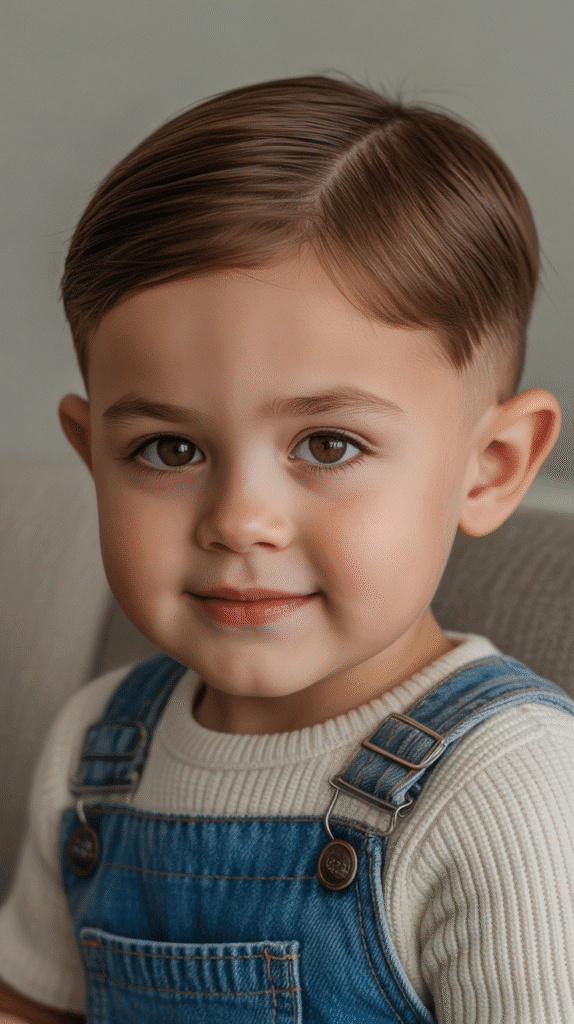
The side part brings a touch of classic gentleman style to your toddler’s look, creating a polished appearance that parents and grandparents alike adore.
This timeless haircut never goes out of style and photographs beautifully for those precious childhood memories.
Timeless Appeal
- The defined side part creates a sophisticated look that transitions seamlessly from playtime to family photos.
- This style works particularly well for toddlers with straight or slightly wavy hair that holds a part naturally.
- Parents love how this cut makes their little boys look polished without appearing overly mature.
- The side part can be adjusted in position to flatter different face shapes and head structures.
- This classic style often reminds parents and grandparents of traditional childhood haircuts from previous generations.
Creating The Perfect Part
- Ask your barber to establish a natural part line that works with your child’s hair growth pattern.
- Use a small amount of lightweight pomade or styling cream on damp hair to help hold the part.
- Comb hair to the side while still damp after bath time for the easiest styling.
- Consider using a soft-bristle brush which is gentler on your toddler’s sensitive scalp.
- The hair on top should be kept at a length that allows it to lay smoothly when combed over.
4. The Buzz Cut

The buzz cut represents the ultimate in low-maintenance haircuts, perfect for parents who want to minimize grooming time while keeping their toddler comfortable and neat.
This super-short style is especially popular during summer months and for extremely active little boys.
Maximum Practicality
- The buzz cut eliminates all styling requirements, making morning routines incredibly simple.
- This haircut is ideal for toddlers who dislike having their hair washed, brushed, or styled.
- Parents of boys with very fine or thin hair often choose this style to avoid the appearance of sparse coverage.
- The extremely short length keeps toddlers cool and comfortable in hot weather or during physical activities.
- This cut can be maintained at home with clippers, saving money on frequent barber visits.
Considerations Before Buzzing
- Ensure your toddler’s head shape works well with very short hair, as this cut reveals the entire head contour.
- A buzz cut will need to be maintained every 2-3 weeks to keep the uniform length.
- Apply sunscreen to your child’s scalp when outdoors, as the short hair provides minimal sun protection.
- Some parents prefer to start with a longer buzz cut (#4 or #5 guard) before going shorter.
5. The Faux Hawk

The faux hawk adds an edgy, fun element to your toddler’s look without going to the extreme of an actual mohawk.
This playful style features longer hair on top that can be styled upward, with shorter, tapered sides that create the signature shape.
Fun And Playful Style
- The faux hawk allows for styling versatility, from spiked up for special occasions to laid flat for everyday wear.
- This cut appeals to parents who want their toddler to have a modern, trendy look that’s still age-appropriate.
- The style works best for boys with thick or medium-density hair that can hold the upward styling.
- Many toddlers enjoy the process of “spiking up” their hair, making it a fun bonding activity.
- The shorter sides keep the overall look practical while the top adds personality and style.
Styling The Faux Hawk
- Use a small amount of strong-hold gel or styling cream when you want to spike the hair upward.
- Apply product to damp hair and use your fingers to push hair toward the center and upward.
- For everyday wear, simply brush or finger-comb the top hair forward without spiking it up.
- This style requires haircuts every 3-4 weeks to maintain the proper proportions between top and sides.
6. The Curly Top

For toddlers blessed with natural curls, the curly top celebrates and showcases those beautiful ringlets while keeping the overall style manageable.
This haircut features shorter sides with length preserved on top to allow curls to form and bounce naturally.
Embracing Natural Texture
- This style allows parents to embrace their child’s natural curl pattern rather than fighting against it.
- The shorter sides prevent the hair from becoming triangular or overly voluminous as it grows.
- Curly-topped toddlers often receive compliments on their adorable, bouncy ringlets.
- This cut works for various curl types, from loose waves to tight coils.
- The natural texture means styling is minimal, requiring only moisture and curl definition.
Caring For Curly Hair
- Use a sulfate-free shampoo designed for curly or textured hair to prevent dryness.
- Apply a leave-in conditioner or curl cream to damp hair to enhance curl definition and reduce frizz.
- Avoid brushing dry curls, which can cause frizz and disrupt the natural curl pattern.
- Use a wide-tooth comb on wet, conditioned hair to gently detangle if needed.
- Schedule haircuts every 6-8 weeks to maintain shape while preserving the curly top length.
7. The Bowl Cut (Modern Version)

The modern bowl cut has evolved significantly from its traditional counterpart, now featuring textured edges and strategic layering that creates a stylish, contemporary look.
This updated version maintains the circular shape while adding movement and dimension.
Contemporary Bowl Cut Features
- The modern bowl cut features textured, point-cut edges rather than the blunt, straight line of traditional versions.
- This style works particularly well for toddlers with fine to medium hair texture that naturally falls smoothly.
- Strategic layering prevents the heavy, helmet-like appearance of old-fashioned bowl cuts.
- The rounded shape frames the face beautifully and creates a sweet, youthful appearance.
- Many stylists add subtle variations in length to create more movement and natural-looking results.
Achieving The Modern Look
- Request point-cutting or texturizing techniques at the ends to soften the perimeter and add movement.
- The hair should fall naturally around the head rather than appearing severely geometric.
- This cut typically requires monthly trims to maintain the shape and prevent it from looking overgrown.
- A light styling cream can help define texture and prevent the hair from looking too flat or one-dimensional.
8. The Ivy League
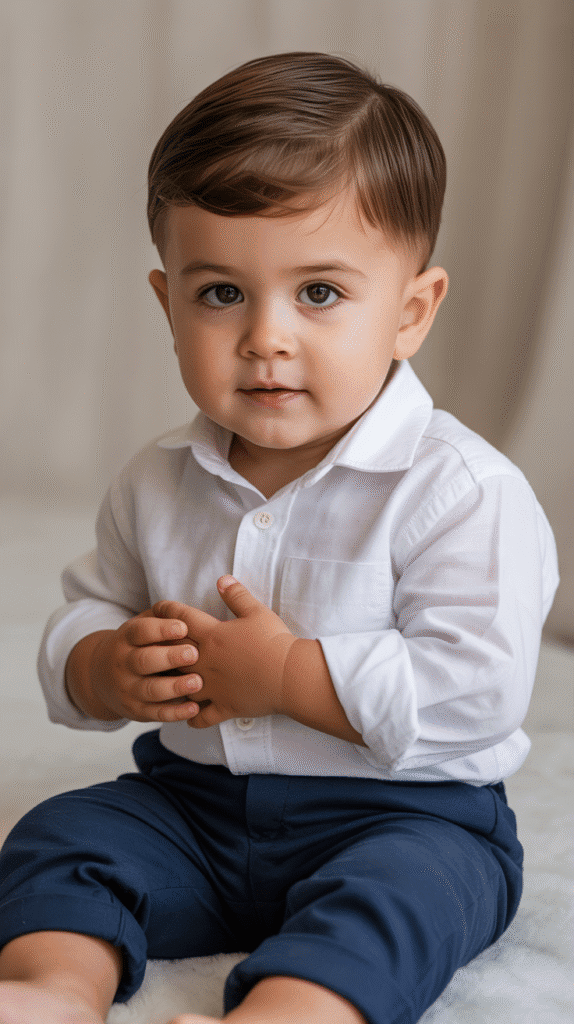
The Ivy League cut offers a slightly longer alternative to the crew cut, featuring more length on top that can be styled forward or to the side.
This sophisticated style balances neat appearance with enough length for minimal styling versatility.
Refined Yet Age-Appropriate
- The Ivy League provides enough length on top to create a soft, natural appearance while maintaining a neat profile.
- This cut is slightly more formal than many toddler haircuts, making it perfect for boys who attend events regularly.
- The style allows for simple forward brushing or side combing depending on the occasion.
- Parents appreciate the classic, preppy aesthetic that photographs beautifully.
- The longer top means this cut doesn’t require as frequent trims as shorter styles.
Styling Options
- Brush the top hair forward for a casual, everyday look that requires no products.
- Add a small amount of light pomade and brush to the side for more formal occasions.
- The length on top should be approximately 1-2 inches to maintain the Ivy League proportions.
- This style grows out gracefully, looking neat even when it’s approaching time for the next haircut.
9. The Shaggy Layers

The shaggy layered cut creates a relaxed, carefree look perfect for toddlers with a fun-loving, energetic personality.
This style features multiple layers throughout that add movement, texture, and a deliberately tousled appearance.
Effortlessly Cool
- The layered approach creates natural movement and prevents hair from appearing flat or lifeless.
- This style is excellent for disguising cowlicks and unusual growth patterns that many toddlers have.
- The intentionally messy appearance means bedhead actually works with this cut rather than against it.
- Shaggy layers work well for various hair textures, from straight to wavy to slightly curly.
- Parents love that this cut looks styled even when no actual styling has been done.
Managing The Shag
- Ask your stylist to add layers throughout the hair rather than creating a single-length cut.
- Use a texturizing spray or light mousse on damp hair to enhance the natural movement.
- This cut benefits from air-drying, which emphasizes the piece-y, textured appearance.
- Schedule haircuts every 6-8 weeks to prevent the layers from growing out into an undefined shape.
- A quick tousle with your fingers is often all the “styling” this cut needs.
10. The Undercut
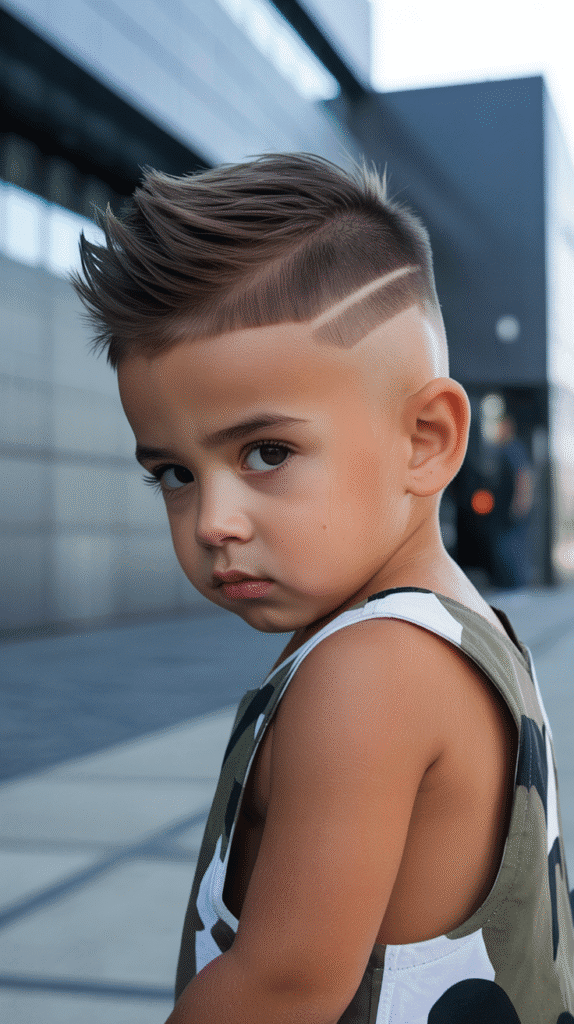
The undercut features dramatically short or even shaved sides with significantly longer hair on top, creating a striking contrast that’s become increasingly popular for toddlers.
This modern style offers a fashion-forward look while remaining practical for active little boys.
Bold And Trendy
- The undercut creates a defined separation between the short sides and longer top, resulting in a crisp, modern aesthetic.
- This cut allows parents to keep the sides extremely manageable while preserving length on top for styling options.
- The style works particularly well for boys with thick hair, as it removes bulk from the sides.
- Many toddlers enjoy the unique look and the attention this distinctive haircut receives.
- The undercut can be styled in multiple ways, from slicked back to textured and tousled.
Maintenance Considerations
- The sides will need to be trimmed every 2-3 weeks to maintain the clean undercut appearance.
- Some barbers can teach parents to maintain the sides at home between full haircuts.
- The top can be styled with various products depending on the desired look for the day.
- This cut requires more commitment than some styles due to the frequent side maintenance needed.
11. The Surfer Style
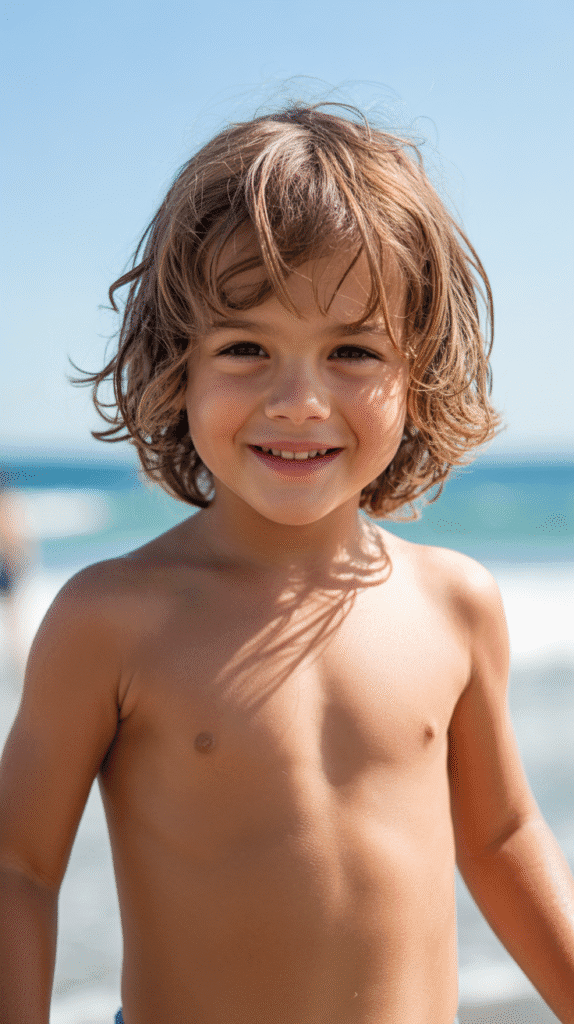
The surfer cut embodies a relaxed, beachy vibe with longer, tousled hair that suggests fun-filled days at the beach or playground.
This laid-back style features natural-looking waves and texture with longer overall length.
Carefree Beach Vibes
- The surfer style celebrates natural texture and movement, requiring minimal styling intervention.
- This cut is ideal for parents who prefer longer hair on their toddlers and don’t mind a more relaxed appearance.
- The longer length works beautifully for boys with natural wave or texture in their hair.
- Many parents appreciate the soft, youthful look that longer, flowing hair creates on toddlers.
- This style allows for versatility, from tucking behind ears to letting it flow freely.
Achieving The Surfer Look
- Ask your stylist to add subtle layers to prevent the hair from appearing too heavy or triangular.
- Use a sea salt spray on damp hair to enhance natural waves and create beachy texture.
- Allow hair to air-dry whenever possible to maximize the natural, effortless appearance.
- This cut requires less frequent haircuts, typically every 8-10 weeks, to maintain the longer length.
- Regular conditioning is important to keep longer hair healthy and prevent tangles.
12. The Caesar Cut

The Caesar cut features short, horizontally-cut bangs and an overall uniform length that creates a distinct, Roman-inspired look.
This classic style has been adapted for toddlers with slightly softer edges and age-appropriate proportions.
Classic Roman Style
- The Caesar cut is characterized by its horizontal fringe that falls forward across the forehead.
- This style works exceptionally well for boys with receding hairlines or larger foreheads, as the bangs provide coverage.
- The uniform length throughout makes this cut relatively simple to maintain and style.
- Many parents choose this cut for its historical connection and timeless masculine appeal.
- The short length keeps the style practical while the forward fringe adds character.
Styling The Caesar
- The bangs should be cut straight across or with slight texture to prevent a harsh, blunt appearance.
- Use your fingers to brush the fringe forward after washing for the characteristic Caesar look.
- This cut requires minimal products, though a small amount of light pomade can help hold the fringe in place.
- Haircuts should be scheduled every 3-4 weeks to prevent the bangs from growing too long and obstructing vision.
13. The Pompadour (Toddler-Friendly)
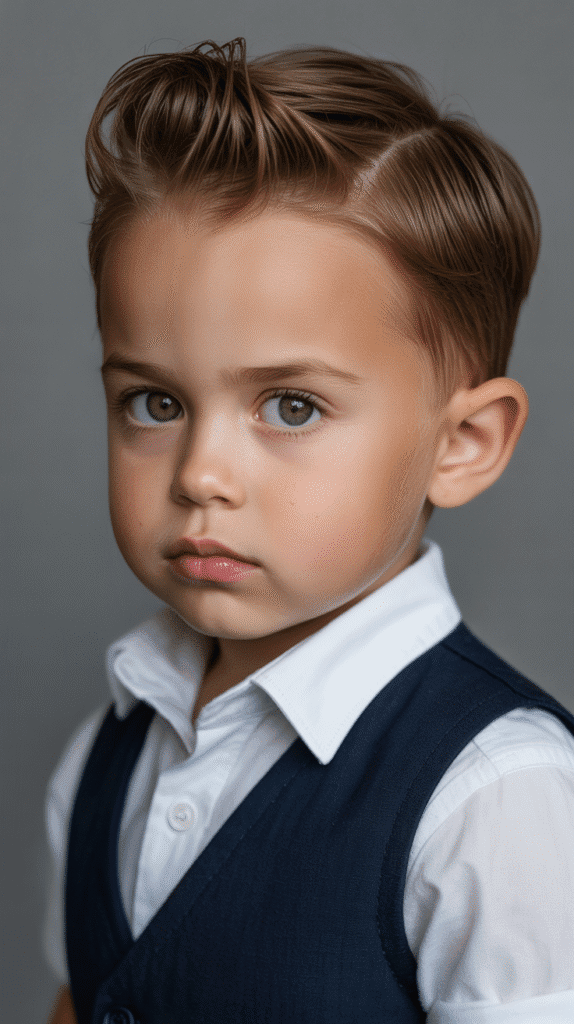
The toddler-friendly pompadour features volume and height on top with shorter sides, creating a miniature version of the classic adult style.
This playful interpretation maintains age-appropriateness while delivering impressive style impact.
Volume And Style
- The toddler pompadour adds height on top without requiring extensive styling time or strong-hold products.
- This cut works best for boys with thick hair that naturally has some volume and body.
- The dramatic styling makes this cut perfect for special occasions like birthday parties or family portraits.
- Many toddlers enjoy the “big boy” feeling this sophisticated style creates.
- The shorter sides keep the overall look balanced and prevent the style from becoming overwhelming.
Creating The Mini Pomp
- Ask your barber to leave 2-3 inches on top while keeping the sides and back short.
- Use a blow dryer on low heat to lift hair up and back while it’s still slightly damp.
- Apply a small amount of mousse or volumizing spray before blow-drying for better hold.
- This style can be brushed down for everyday wear and styled up for special occasions.
- Schedule haircuts every 3-4 weeks to maintain the proportions between top and sides.
14. The Tapered Cut
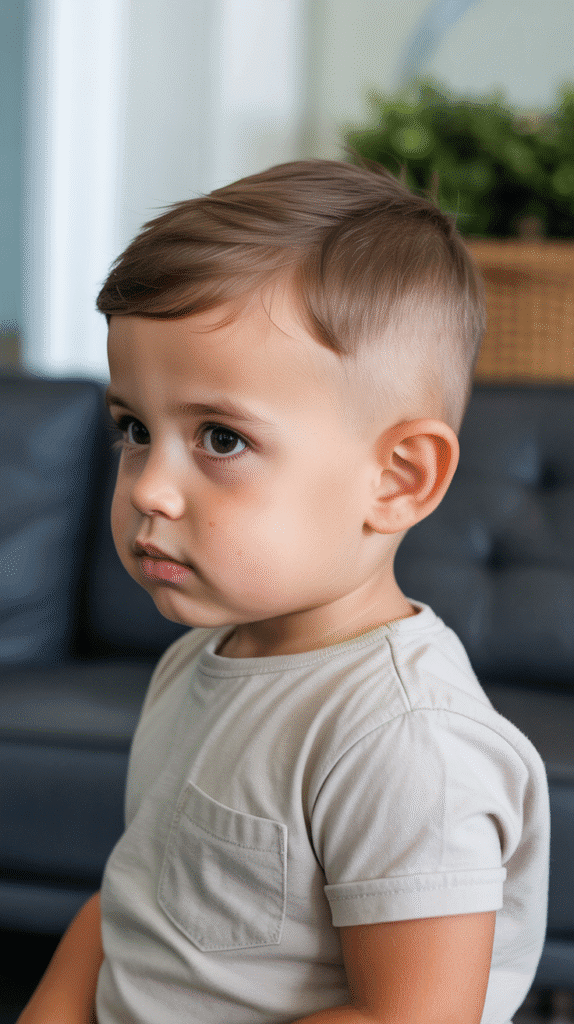
The tapered cut gradually decreases in length from top to bottom, creating a smooth, blended transition that looks polished and professional.
This versatile style works for virtually all hair types and face shapes.
Smooth Transitions
- The tapered approach eliminates harsh lines, creating a soft, natural-looking gradient throughout the haircut.
- This style is incredibly versatile, working as a foundation for many other haircut styles and variations.
- The gradual length change means the cut grows out gracefully, looking neat for longer between haircuts.
- Parents appreciate the professional, put-together appearance this cut provides.
- The taper can be adjusted to be subtle or more pronounced depending on personal preference.
Taper Variations
- A low taper begins the length transition near the ears, creating a more conservative look.
- A mid taper starts the transition higher up the sides, offering a more contemporary appearance.
- A high taper begins the fade near the top of the head, creating maximum contrast.
- Ask your barber about the taper length and placement that will best suit your toddler’s head shape and hair type.
- This cut typically requires trims every 4-5 weeks to maintain the blended appearance.
15. The Fringe Cut

The fringe cut features longer bangs that fall across the forehead, creating a youthful, playful look that many toddlers and parents love.
This style offers coverage on top while maintaining shorter sides for practicality.
Youthful And Playful
- The longer fringe creates a sweet, innocent appearance that emphasizes your toddler’s youth.
- This cut allows for styling versatility, with bangs worn down, swept to the side, or even pinned back when needed.
- The fringe can help disguise a larger forehead or balance facial proportions.
- Many boys enjoy having longer hair to touch and play with, and the fringe satisfies this desire safely.
- This style photographs beautifully, often creating that perfect peek-a-boo effect in portraits.
Managing The Fringe
- The bangs should be cut to end at or just above the eyebrows to prevent vision obstruction.
- Use a small amount of lightweight cream to keep the fringe in place without making it look greasy or stiff.
- Regular fringe trims every 2-3 weeks may be needed between full haircuts to keep bangs at the appropriate length.
- Consider teaching your toddler to brush his fringe to the side, which can extend time between bang trims.
16. The Comb Over
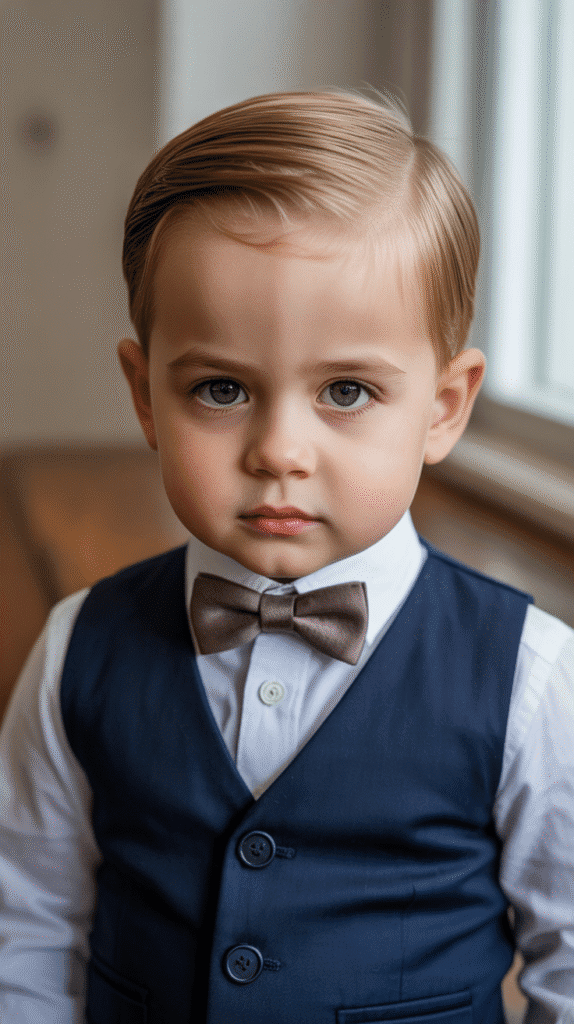
The comb over for toddlers features longer hair on top combed to one side, creating a sophisticated, gentleman-like appearance.
This style combines classic appeal with modern execution for an age-appropriate yet polished look.
Sophisticated Charm
- The comb over creates a refined appearance that works beautifully for formal occasions and everyday wear alike.
- This style allows for more length on top while maintaining neat, shorter sides for balance.
- The side-swept look helps create the illusion of fuller hair for boys with finer textures.
- Parents appreciate the mature, put-together aesthetic this cut provides without being overly adult.
- The comb over can be adjusted in direction and volume to suit different face shapes and preferences.
Perfecting The Comb Over
- Apply a small amount of light-hold pomade or cream to damp hair before combing.
- Use a fine-tooth comb to sweep hair from one side to the other, creating a defined line.
- The hair on top should be approximately 2-3 inches long to achieve the proper comb over proportions.
- This style requires daily attention after bathing but only takes a minute or two to achieve.
- Schedule haircuts every 4-5 weeks to maintain the length and shape.
17. The Mullet (Modern Version)

The modern mullet has made a surprising comeback in children’s hairstyles, featuring shorter hair on top and sides with length preserved in the back.
When done well, this updated version looks playful and intentional rather than dated.
Business In Front, Party In Back
- The modern toddler mullet features more blending and texture than traditional versions, creating a contemporary interpretation.
- This unconventional choice appeals to parents who want their child to have a unique, memorable hairstyle.
- The style works surprisingly well for active toddlers, keeping hair out of their face while preserving length.
- Many families choose this cut as a fun, temporary style to try while their child is young.
- The mullet has become trendy again among young families who appreciate its playful, ironic appeal.
Executing The Modern Mullet
- Ask your stylist to avoid creating a dramatic, harsh transition between the short front and long back.
- The back length should be proportionate to your toddler’s overall size, typically no longer than collar length.
- Add texture throughout to prevent the style from looking too severe or costume-like.
- This cut requires maintenance every 4-6 weeks to keep the proportions balanced as hair grows.
18. The Slick Back
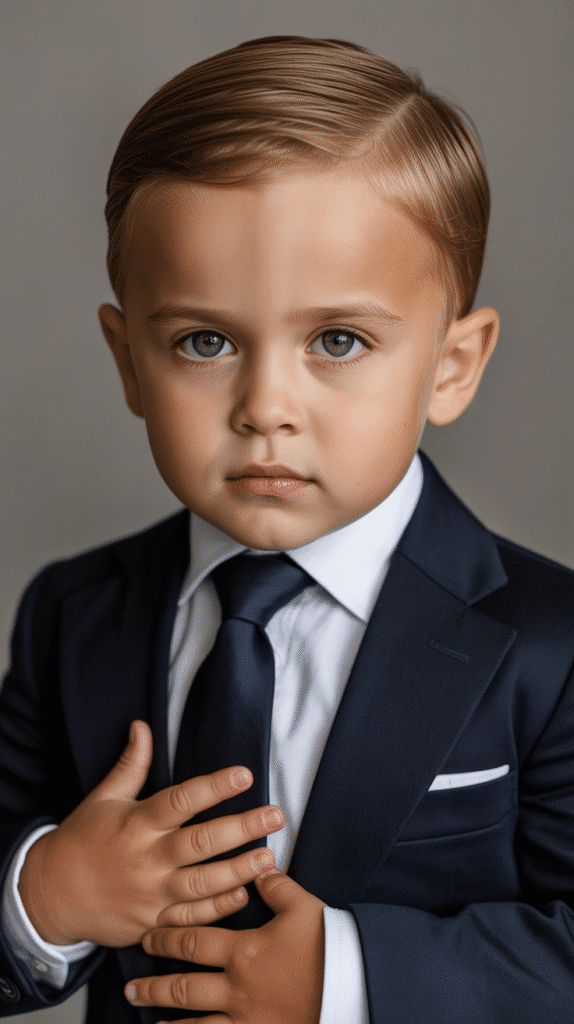
The slicked-back style features hair brushed back away from the face, creating a sophisticated, vintage-inspired look for toddlers.
This polished style works best for special occasions or family photos when you want maximum impact.
Polished Perfection
- The slick back creates an incredibly refined appearance that makes toddlers look like miniature gentlemen.
- This style works best for boys with straight or slightly wavy hair that can be easily smoothed back.
- The dramatic styling makes this cut ideal for weddings, formal events, or professional family portraits.
- Many parents use this style occasionally for special events rather than as an everyday look.
- The slicked appearance showcases your toddler’s facial features beautifully by removing hair from the face entirely.
Achieving The Slick Back
- Apply a pomade or gel with medium to strong hold to damp hair, working it through evenly.
- Use a fine-tooth comb to brush all hair straight back from the forehead toward the crown.
- A blow dryer on low heat can help set the style and speed up drying time.
- This style requires product and effort, so it’s best reserved for special occasions rather than daily wear.
- Keep the sides relatively short to create the proper slick back proportions and prevent excessive volume.
19. The Spiky Top

The spiky top features short sides with longer hair on top styled upward into defined spikes, creating a fun, energetic look that many toddlers love.
This playful style allows for personality expression while remaining age-appropriate.
Fun And Energetic
- Spiky hair creates a fun, playful appearance that matches the energetic personality of most toddlers.
- This style allows boys to express their individuality through a distinctive, eye-catching look.
- The vertical styling adds height, which can be flattering for various face shapes and head structures.
- Many toddlers enjoy participating in the spiking process, making hair time a fun bonding activity.
- The short sides keep the overall look practical despite the styled top.
Creating Perfect Spikes
- Use a strong-hold gel or spiking wax designed specifically for children’s sensitive scalps.
- Apply product to damp hair, then use your fingers to twist small sections upward into spikes.
- The spikes should be proportionate to your toddler’s head size, typically no more than an inch tall.
- This style requires some time and effort to achieve, so consider it for special days or when you have extra time.
- The top length should be approximately 1.5-2 inches to create spikes without being too long or heavy.
20. The Long Top, Short Sides

This versatile style combines longer hair on top with much shorter sides, creating contrast and allowing for multiple styling options.
The adaptable nature makes it one of the most popular choices among modern parents.
Maximum Versatility
- The length contrast allows parents to style the top in various ways depending on the day or occasion.
- This cut works for virtually all hair types, from straight to curly, fine to thick.
- The longer top provides enough length for creative styling without being difficult to manage.
- Parents can brush the top forward, to the side, up, or back for completely different looks.
- The short sides ensure the overall cut remains practical and easy to maintain between styling.
Styling Possibilities
- For casual days, simply brush or finger-comb the top forward for a relaxed look.
- Add product and sweep hair to the side for a more polished, formal appearance.
- Create height by blow-drying the top upward and using a light styling cream.
- The top length should be approximately 2-4 inches, depending on your preference and your toddler’s hair texture.
- This cut requires haircuts every 3-4 weeks to maintain the contrast between top and sides.
21. The Wavy Natural

The wavy natural cut celebrates and enhances natural wave pattern, featuring strategic layering and shaping that allows waves to form beautifully.
This low-maintenance style works with your toddler’s natural texture rather than against it.
Embracing Natural Waves
- This cut is designed specifically for boys with natural wave in their hair, showcasing the texture beautifully.
- The styling approach emphasizes and enhances natural patterns rather than trying to straighten or flatten them.
- Parents love that this cut requires minimal daily maintenance while looking intentionally styled.
- The waves add movement and dimension that create visual interest without requiring products or tools.
- This style grows out gracefully, with waves naturally adjusting as length increases.
Wave-Enhancing Techniques
- Use a lightweight leave-in conditioner or wave cream on damp hair to define and separate waves.
- Scrunch hair gently with your hands while drying to encourage wave formation.
- Avoid brushing dry wavy hair, which can disrupt the natural pattern and create frizz.
- Ask your stylist to add layers that work with the natural wave pattern rather than creating bulk.
- This cut benefits from haircuts every 6-8 weeks to maintain shape and prevent excessive volume.
22. The Clean Fade
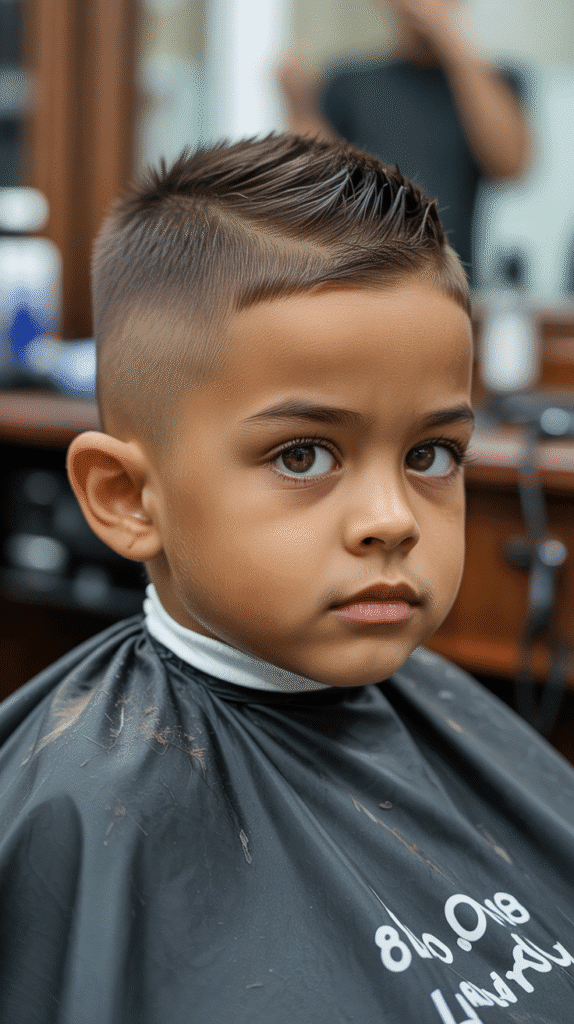
The fade features hair that gradually decreases from longer on top to extremely short or skin-level on the sides and back.
This precise, technical cut creates a sharp, clean appearance that looks professionally styled.
Precision And Sharpness
- The fade creates an ultra-clean appearance with precise lines that look freshly cut.
- This technical cut showcases skilled barber work and creates a premium, high-end look.
- The gradual transition from length to skin creates visual interest and dimension.
- Parents appreciate the neat, tidy appearance that makes toddlers look well-groomed and cared for.
- The fade works beautifully when combined with various top styles, from textured to slicked.
Fade Variations
- A low fade begins the transition near the ears and neckline, creating a subtle effect.
- A mid fade starts the transition higher on the head, offering more contrast and impact.
- A high fade begins the transition near the top of the head, creating maximum drama.
- A skin fade takes the sides down to skin level, while a regular fade leaves some visible hair.
- This cut requires maintenance every 2-3 weeks to keep the fade looking sharp and well-defined.
23. The Brushed Up
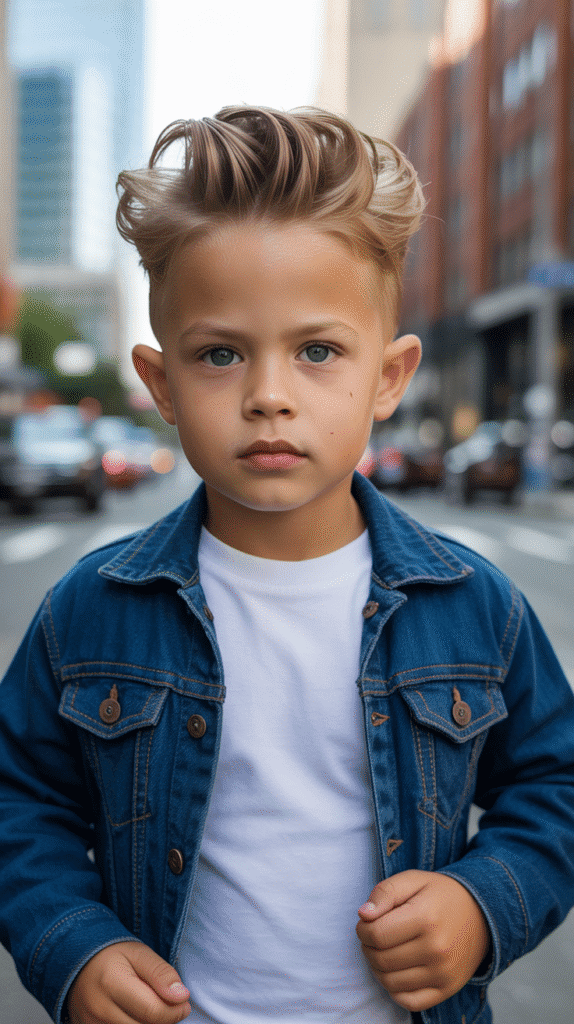
The brushed-up style features hair styled upward and slightly back, creating volume and height that adds visual interest.
This modern look works particularly well for boys with thick hair that holds shape easily.
Volume And Height
- Brushing hair upward creates the illusion of fuller, thicker hair for boys with finer textures.
- This style adds height, which can be flattering for round or wider face shapes.
- The vertical styling creates a modern, fashion-forward appearance that photographs beautifully.
- Parents appreciate that this style can be achieved quickly with the right products and technique.
- The brushed-up look works for both casual and formal occasions depending on execution.
Styling Technique
- Apply a volumizing mousse or spray to damp hair before styling.
- Use a blow dryer on medium heat, directing airflow upward while brushing hair up and back.
- Finish with a small amount of light-hold product to maintain the style throughout the day.
- The hair on top should be 2-3 inches long to achieve proper brushed-up volume without becoming unmanageable.
- This style takes 3-5 minutes to achieve, making it suitable for families willing to invest minimal morning styling time.
24. The Asymmetrical Cut

The asymmetrical cut features intentionally uneven lengths, typically with one side longer than the other, creating a unique, artistic appearance.
This unconventional style appeals to parents seeking something truly distinctive for their toddler.
Artistic And Unique
- The asymmetrical approach creates a one-of-a-kind look that ensures your toddler stands out from the crowd.
- This style works particularly well for boys with thick, straight hair that can showcase the intentional length difference.
- The artistic nature of this cut appeals to creative families who appreciate unconventional aesthetics.
- Many parents choose asymmetrical cuts for their bold, fashion-forward statement.
- The uneven lengths create visual interest and movement that photographs beautifully from all angles.
Creating The Asymmetry
- One side is typically cut shorter (often clipper-cut) while the other maintains 2-3 inches of length.
- The longer side can be styled forward, swept across, or tucked behind the ear for different looks.
- Ask your stylist to create a gradual transition rather than an abrupt change for a more wearable result.
- This cut requires a skilled stylist who understands how to balance asymmetry without creating an unflattering appearance.
- Maintenance is needed every 4-5 weeks to preserve the intentional length differences as hair grows.
25. The Mohawk (Faux Version)

The faux mohawk for toddlers creates the illusion of a mohawk through styling rather than shaving the sides completely.
This playful interpretation allows for the edgy look while maintaining versatility for different occasions.
Edgy Yet Adaptable
- The faux mohawk delivers the distinctive center strip styling without the commitment of actually shaving sides.
- This style can be brushed down for conservative settings and spiked up for playtime or casual outings.
- Parents appreciate the flexibility this cut offers compared to a true mohawk.
- The look works best for boys with thick hair that has enough body to hold the upward styling.
- Many toddlers love the “tough guy” feeling this distinctive style creates.
Styling The Faux Hawk
- The center strip should be approximately 2-3 inches longer than the sides for proper mohawk proportions.
- Apply strong-hold gel or mohawk-specific styling wax to damp hair in the center section.
- Use your fingers to push hair upward along the center line, creating the signature raised strip.
- The sides should be tapered or faded but not completely shaved, maintaining some length.
- This style requires haircuts every 3-4 weeks and styling time of 5-7 minutes for the spiked look.
26. The Side Swept
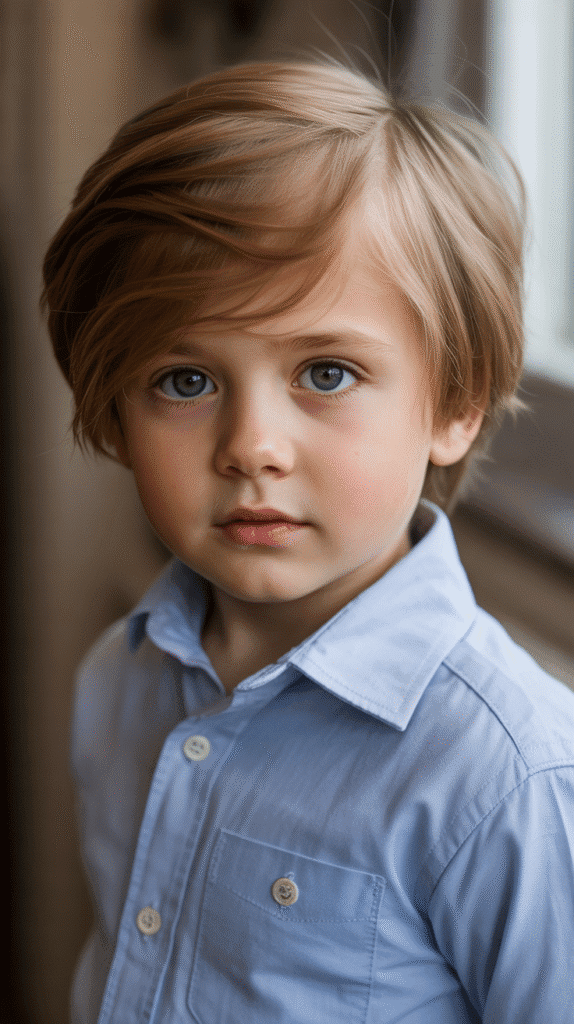
The side-swept style features longer hair brushed dramatically to one side, creating an elegant, sophisticated appearance.
This romantic, windswept look works beautifully for formal occasions and everyday wear alike.
Elegant And Romantic
- The side sweep creates a soft, gentle appearance that emphasizes your toddler’s youthful features.
- This style works particularly well for boys with straight or slightly wavy hair that falls smoothly.
- The dramatic sweep to one side creates visual interest and asymmetry that’s naturally flattering.
- Parents love how this cut looks both casual when air-dried and polished when styled with product.
- The longer length allows for the dramatic sweep while shorter sides keep the overall look balanced.
Achieving The Sweep
- The top and front should be approximately 3-4 inches long to create a proper side sweep.
- Apply a small amount of lightweight cream to damp hair before sweeping to one side.
- Use your fingers or a soft brush to direct all top hair to the preferred side.
- A small amount of hairspray can help maintain the sweep for special occasions or windy days.
- This cut requires trims every 5-6 weeks to maintain length and shape.
27. The Textured Quiff

The textured quiff combines volume, height, and forward-facing texture to create a modern, stylish look.
This sophisticated yet age-appropriate style has become increasingly popular for fashion-conscious families.
Modern Sophistication
- The quiff creates impressive height and volume in the front, adding drama and style impact.
- This cut works best for boys with thick or medium-density hair that can support the volume.
- The textured approach prevents the quiff from looking too stiff or formal for a toddler.
- Parents appreciate that this style can be toned down for everyday wear or amplified for special occasions.
- The quiff showcases your toddler’s facial features by keeping hair up and away from the face.
Building The Quiff
- Apply volumizing mousse to damp hair, focusing on the front section.
- Use a blow dryer and round brush to lift the front hair upward and slightly forward.
- The front section should be 2-3 inches long, with gradually shorter hair moving toward the crown.
- Add a small amount of light-hold pomade or cream to define texture and hold the shape.
- This style requires 5-7 minutes of styling time and haircuts every 3-4 weeks.
28. The Dutch Boy
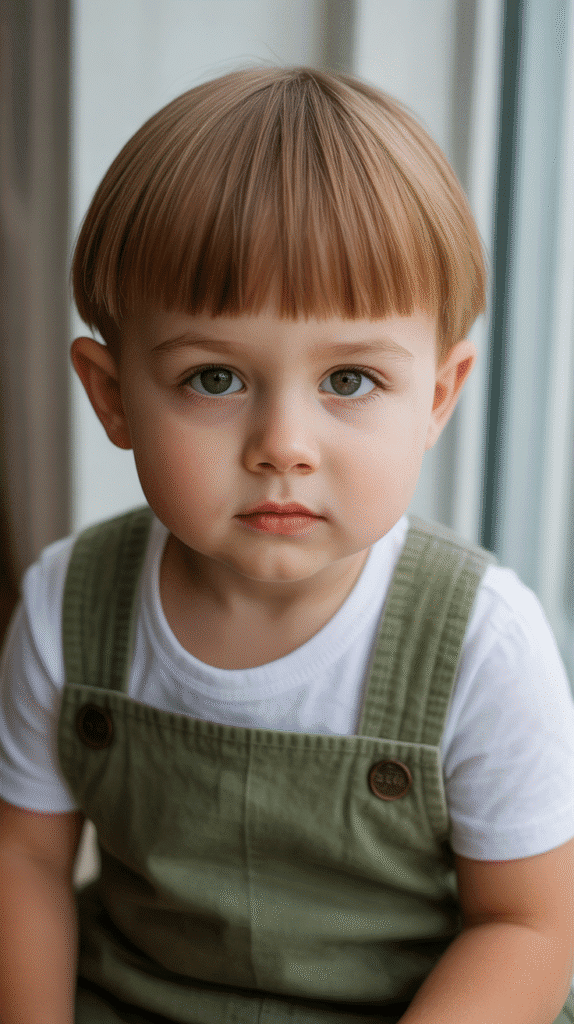
The Dutch Boy cut features straight-across bangs and a rounded shape that creates a sweet, innocent appearance reminiscent of classic European children’s styles.
This timeless look has maintained popularity for generations.
Timeless Innocence
- The Dutch Boy cut creates an unmistakably youthful, innocent appearance that many parents adore.
- This style works particularly well for boys with fine to medium hair that lays flat naturally.
- The straight-across bangs and rounded perimeter create a distinctive, recognizable silhouette.
- Many families choose this cut for its nostalgic connection to classic childhood portraits.
- The simple, uniform shape requires minimal daily styling or maintenance.
Maintaining The Dutch Boy
- The bangs should be cut straight across at eyebrow level or slightly above.
- The overall shape should form a gentle dome or bowl shape around the head.
- Request softened edges using point-cutting techniques to prevent an overly severe appearance.
- This cut requires bang trims every 2-3 weeks and full haircuts every 4-6 weeks.
- A quick brush-through after washing is typically all the styling this cut needs.
29. The Tapered Sides With Curls

This style combines the practicality of tapered sides with the beauty of natural curls on top, creating a balanced look that’s both manageable and visually appealing.
The approach celebrates natural curl while preventing excessive volume.
Balanced Curl Management
- The tapered sides remove bulk and prevent the triangular shape that often develops with all-over curly hair.
- This cut showcases beautiful natural curls on top while keeping the overall style neat and controlled.
- Parents appreciate how this approach makes curly hair more manageable without sacrificing the curls themselves.
- The contrast between smooth tapered sides and textured curly top creates visual interest.
- This style works for various curl types, from loose waves to tight coils.
Curl Care Essentials
- Use a moisturizing shampoo and conditioner designed specifically for curly or textured hair.
- Apply curl-defining cream or gel to wet hair, scrunching gently to encourage curl formation.
- Never brush or comb dry curls, which causes frizz and disrupts the natural curl pattern.
- The curly top should be approximately 2-3 inches long for proper proportion with tapered sides.
- Schedule haircuts every 4-6 weeks to maintain the taper while preserving curl length.
30. The Classic Short All-Over

The classic short all-over cut maintains uniform length throughout the entire head, creating a simple, timeless appearance.
This no-fuss style remains popular with parents who prioritize ease and practicality above all else.
Ultimate Simplicity
- The uniform length throughout eliminates any styling requirements or daily maintenance routines.
- This cut is perfect for extremely active toddlers who are constantly moving, playing, and getting messy.
- Parents love the democratic nature of this cut, which looks neat from every angle.
- The short length keeps toddlers comfortable in all weather conditions and activity levels.
- This style can be maintained at home with clippers, making it the most economical option.
Choosing The Right Length
- A #4 guard (1/2 inch) provides coverage while remaining very manageable and comfortable.
- A #3 guard (3/8 inch) offers even lower maintenance with slightly shorter length.
- A #5 guard (5/8 inch) works well for parents who want short but not extremely short hair.
- The uniform approach means this cut grows out evenly without developing awkward stages.
- Maintenance can be done every 3-4 weeks at home or at a barber.
Home Maintenance Tips
- Invest in quality clippers with adjustable guards for consistent results.
- Cut hair when dry for more accurate length assessment.
- Work against the direction of hair growth for even coverage.
- Take your time around ears and the neckline for clean results.
- Watch tutorial videos specific to cutting toddler hair before attempting home cuts.
Practical Considerations For Toddler Haircuts
Choosing The Right Style
Before selecting a haircut from the 30 options presented, consider several important factors that will impact both appearance and practicality.
- Hair Texture: Straight hair works well with sleek styles, while curly hair shines in cuts that embrace natural texture.
- Growth Patterns: Cowlicks and unusual growth patterns may dictate which styles will be easiest to maintain.
- Lifestyle: Extremely active toddlers benefit from shorter, low-maintenance cuts that won’t interfere with play.
- Face Shape: Certain cuts flatter specific face shapes, with height adding length to round faces and width balancing longer faces.
- Personality: Match the haircut to your toddler’s personality, from bold and edgy to classic and timeless.
Making Haircuts Easier
- Schedule appointments during times when your toddler is typically well-rested and fed.
- Bring favorite toys, snacks, or tablets to keep your toddler occupied during the cut.
- Consider barbers or salons that specialize in children’s haircuts with appropriate seating and entertainment.
- Practice sitting still at home before the first haircut to establish expectations.
- Offer specific rewards for cooperative behavior during haircuts to create positive associations.
Communication With Your Barber
- Bring reference photos showing exactly what you want from multiple angles.
- Discuss your lifestyle and how much time you can realistically dedicate to styling.
- Ask about growth patterns and which styles will work best with your child’s specific hair.
- Inquire about maintenance schedules and what will be required between appointments.
- Request styling demonstrations so you can recreate the look at home.
Conclusion
Choosing among these 30 cute toddler boy haircuts every parent will love ultimately comes down to finding the perfect balance between style, practicality, and your child’s unique characteristics.
From the timeless appeal of the classic crew cut to the modern edge of the undercut, each style offers distinct advantages that cater to different lifestyles, hair types, and aesthetic preferences.
Remember that the best haircut for your toddler is one that makes both of you happy—one that’s manageable for your daily routine while making your little boy feel confident and look absolutely adorable.
Consider your child’s activity level, hair texture, and personality when making your selection, and don’t be afraid to try different styles as your toddler grows and his preferences evolve.
Whether you choose a low-maintenance buzz cut for your active explorer or a stylish textured crop for your fashion-forward little gentleman, the right haircut will enhance your toddler’s natural charm while simplifying your grooming routine.
With the comprehensive information provided about each of these 30 cute toddler boy haircuts every parent will love, you’re now equipped to make an informed decision that will keep your little one looking sharp, feeling comfortable, and ready to take on the world with confidence and style.
